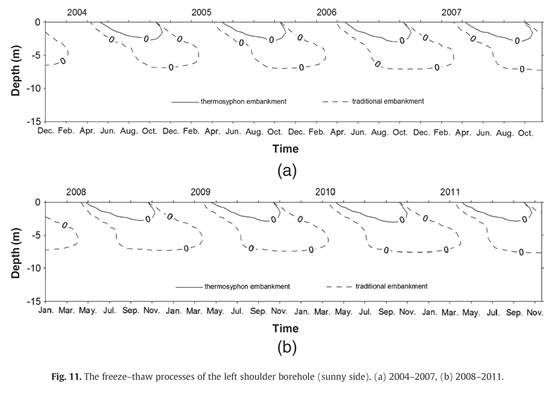The two-phase closed thermosyphon is an effective thermal semiconductor which can decrease the ground temperature of the underlying permafrost only in cold seasons, but does not transfer thermal energy in warm seasons. In this paper, based on the monitoring data of experimental embankment of the Qinghai–Tibet Highway from 2004 to 2011, the working state, temperature distributions and freeze–thaw process of embankment armed with two-phase closed thermosyphon were analyzed. It was found that thermosyphon embankment could play a rapid cooling effect after construction, which can weaken the sunny side-slope thermal effect and ensure the stability of embankment effectively. Compared with traditional embankment, the thermosyphon embankment offered a relatively long freezing period in a year for the underlying permafrost. For this reason, a relatively stable low-temperature zone around thermosyphon was formed. The monitoring data indicated that the artificial permafrost table beneath the thermosyphon embankment elevated to or maintained at the natural level. The thermosyphon can help to enhance the capability of defending against climate warming and further to increase the long-term stability of the embankment in permafrost regions.

Yi Song, Long Jin, Jinzhao Zhang. In-situ study on cooling characteristics of two-phase closed thermosyphon embankment of Qinghai-Tibet Highway in permafrost regions. Cold Regions Science and Technology. Doi: 10.1016/j.coldregions.2013.05.002.
http://www.sciencedirect.com/science/article/pii/S0165232X13000761#
 © 2015 Institute of Earth Environment,CAS
© 2015 Institute of Earth Environment,CAS Address:No. 97 Yanxiang Road, Xi'an 710061, Shaanxi, China

 Location :
Location :